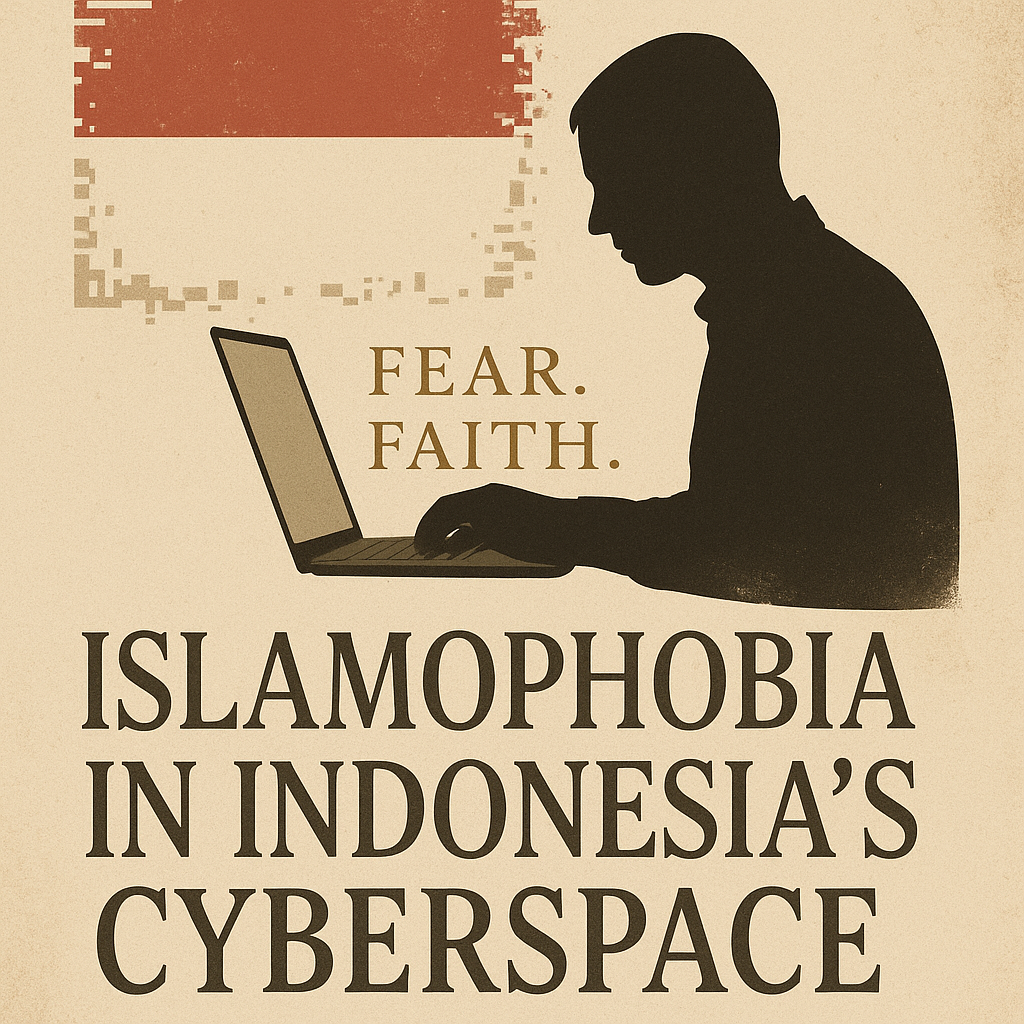Your cart is currently empty!

Islamophobia in Indonesia’s Cyberspace: Politics, Buzzers, and Virtual Fear
Introduction: When Faith Meets Algorithms
Why is Islamophobia intensifying in Indonesia’s digital public sphere?
This question becomes urgent when we observe how political polarization and algorithmic manipulation have transformed social media into a battlefield of identities. Through virtual ethnography, this article explores how fear, faith, and political machinery intertwine in Indonesian cyberspace.
The phenomenon is not merely about prejudice against Muslims—it reflects a broader pattern of digital distrust and state-sponsored narratives that manipulate religion for political consolidation. From Facebook groups to WhatsApp chains, from TikTok comment sections to X (formerly Twitter) hashtags, the Indonesian virtual world is saturated with disinformation and hate campaigns, particularly during political contestations.
The presidential elections during Joko Widodo’s era became the perfect storm—religious identity transformed into political ammunition, and cyberspace became an open theatre of ideological war.
The Role of Buzzers: Cyber Militias of the Republic
In recent years, the Indonesian digital ecosystem has given birth to what I call “cyber militias”—armies of buzzers aligned with political and economic patrons. Their task is simple: manufacture consensus, attack dissenters, and weaponize public sentiment.
It has become dangerously easy to accuse a group of being “radical” simply because they oppose a government policy. Anyone beyond the umbrella of Nahdlatul Ulama (NU) or Muhammadiyah—the two largest Islamic organizations—faces suspicion. Even scholars like myself, who have studied Islamic movements for decades, risk being labeled as sympathizers of extremism merely by discussing the concept of Daulah Islamiyah in academic terms.
The digital environment punishes nuance. Silence becomes safer than speech.
Critics from anti-government groups often face legal intimidation under the pretext of combating hate speech or radicalism, while pro-government commentators—no matter how vitriolic—enjoy impunity.
Thus, the “brotherhood of the nation” (ukhuwah wathaniyah) has been fractured, replaced by selective justice and algorithmic bias. WhatsApp groups circulate conspiracy theories; Telegram channels strategize political influence; Facebook and TikTok amplify hostility. Indonesia’s cyberspace has turned into a psychological battlefield where buzzers earn their living by selling narratives of fear.
Historical Roots: Islamophobia in the Indonesian Imagination
To understand this digital Islamophobia, one must return to its historical genealogy. In 1999, historian Prof. Taufik Abdullah, former head of LIPI, wrote a seminal essay titled “Islamophobia.” He argued that the fear of Islam in Indonesia has always been a projection of minority insecurity rather than an intrinsic characteristic of Islam itself.
“With the existence of Darul Islam,” wrote Taufik Abdullah, “there is a myth that Islam in Indonesia is militant and therefore frightening… Islamophobia is more due to the perceived lack of self-confidence of minorities. Islam is not monolithic—just look at NU and Al-Washliyah.”
During the New Order, the regime institutionalized Islamophobia. “Extremism” became a euphemism for Islamic activism, while “communism” was labeled as left-wing extremism. Suharto’s bureaucratic apparatus weaponized fear to maintain political control. When Suharto later approached Islam through the formation of ICMI (Indonesian Muslim Scholars Association) and the rise of B.J. Habibie, Christian elites grew anxious that Islam was becoming part of the authoritarian establishment.
Throughout these eras—from colonial rule to the Reformasi—Islam was simultaneously courted and feared, empowered and restrained, depending on who controlled the state narrative.
From Reformasi to Terror: The New Language of Suspicion
After 9/11, Indonesia entered the global “War on Terror” discourse. Bombings in Jakarta and Bali pushed Islam into an international spotlight of suspicion. The U.S. anti-terror campaign influenced Indonesian security policy, transforming local counter-terrorism efforts into a mirror of global Islamophobia.
During this period, I personally engaged in deconstructing terrorism narratives, analyzing the ideological texts of Jemaah Islamiyah. In Negara Tuhan was part of an intellectual resistance against the simplification of Islam as a source of terror. Yet despite these efforts, the word “terrorism” became a political currency used to silence Islamic discourse.
The creation of Densus 88, Indonesia’s elite counter-terrorism unit, reinforced this structure of suspicion. Funded and trained partly by foreign partners, Densus 88 became the “golden boy” of security operations. While many of its missions were justified, its prominence also helped to institutionalize the idea that “radicalism” is the exclusive property of Muslim communities.
The Bureaucracy of Fear: Counter-Terrorism and Its Politics
By the time of President Susilo Bambang Yudhoyono, the state had perfected a nationwide counter-terrorism network. Coordination among the TNI, Polri, and BNPT (National Counterterrorism Agency) created overlapping jurisdictions—often leading to friction, duplication, and sectoral ego.
These bureaucratic rivalries, however, did not stop the expansion of counter-terrorism programs into schools, mosques, and universities. The line between “security” and “surveillance” blurred. Civil servants, teachers, and even religious leaders began to self-censor, afraid of being reported for harboring “radical ideas.”
In this environment, Islamophobia mutated—it became administrative. Suspicion was no longer expressed through open hostility but through policy frameworks, screening mechanisms, and social labeling.
War on Terror in the Age of Social Media
The arrival of social media gave the old fear a new platform. Political consultants and digital strategists weaponized public discourse by associating dissent with radicalism. The narrative became binary:
-
Support the government, and you are moderate.
-
Criticize it, and you are radical.
Buzzers became digital mercenaries. They manufactured fear while selling loyalty. The state’s campaign against radicalism morphed into a populist tool for delegitimizing opposition.
Through hashtags, memes, and viral videos, Islamophobia evolved into a participatory spectacle—where ordinary users, often unknowingly, reproduced the language of fear. The government benefited: social media became both the mirror and the megaphone of its ideological narrative.
Oligarchy, Communism, and the Return of the Ghosts
Behind the state apparatus, oligarchic interests flourish. The anti-radicalism discourse conveniently clears the path for investment and deregulation while weakening critical Islamic voices that could question corruption or inequality.
Meanwhile, remnants of left-wing ideological groups, once silenced by the New Order, now reappear under the rhetoric of pluralism and democracy. The anti-communist campaign—once fierce—has quietly faded since 2016. Today, the same state that once executed communists now allows their sympathizers to re-enter public institutions, even the military recruitment system.
Thus, Indonesia finds itself haunted by its own ghosts: Islamophobia from above and ideological confusion from below. The digital age has not healed these old wounds—it has amplified them.
What Comes Next?
Indonesia’s cyberspace remains a contested territory where religion, nationalism, and power collide. The future of digital democracy depends on whether the nation can separate religious critique from religious hatred, and security discourse from political manipulation.
If fear continues to dominate the algorithm, Islamophobia will not disappear—it will evolve into subtler, more insidious forms: in hiring practices, university discourse, policy planning, and online censorship.
Ultimately, the persistence of Islamophobia reveals a deeper malaise: the failure to trust citizens as moral and rational beings. As long as suspicion remains the default language of governance, Indonesia will keep replaying the same drama—where Islam is both needed and feared, praised and punished, celebrated and surveilled.


Leave a Reply